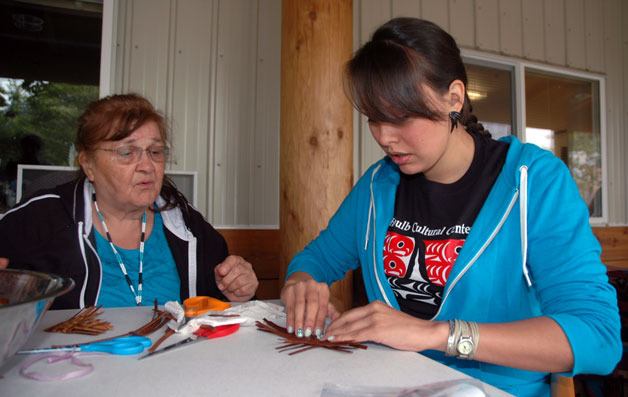TULALIP — The Hibulb Cultural Center marked its first-year anniversary during the weekend of Aug. 17-19 by serving as the site for storytellers, craft-makers, gardeners and film screenings for three days.
While Tulalip Tribal member James Madison covered Coast Salish painting on Saturday, Aug. 18, the afternoon of Sunday, Aug. 19, saw Cy and Tim Williams demonstrating chainsaw-carving before Steve Madison led a Pacific Northwest drawing workshop.
On the morning of Aug. 18, Hibulb Cultural Center Director Hank Gobin led the official opening program for the event, during which Tulalip Tribal elder David Spencer sang a prayer, and Tulalip Tribal Secretary Glen Gobin and Chair Mel Sheldon Jr. shared their thoughts on the significance of the Hibulb Cultural Center’s existence.
“It seems like just yesterday since it opened, but it also seems like it was years ago, since it was planned for so many years,” Glen Gobin said. “Our culture is what sustains and keeps us strong as we go forward. Without it, we drift like leaves in the wind. This facility collects the teachings of our elders, shares them and passes them on.”
Glen Gobin acknowledged that the Tulalip Tribes traditionally passed on their history through word-of-mouth and shared experiences, but touted the Hibulb Cultural Center as another avenue of preserving that ancestral knowledge, since the pace and obligations of modern times make it more difficult for Tribal members to gather on the beach of Tulalip Bay.
“If you do a thing with the right intentions in your heart, your elders will accept it,” Glen Gobin said.
Sheldon praised the Hibulb Cultural Center for affording a glimpse into the Tulalip Tribes’ past prior to their contact with European settlers, back when they lived off the land. While he’s heartened to see his fellow Tulalip Tribal members attending the Hibulb Cultural Center’s programs and perusing its exhibits, he also hopes to continue seeing tourist traffic from outside of the reservation as well.
“We’re sharing the Tulalip Tribes with the greater community,” Sheldon said. “We’re sharing who we are, and what we are, so that it can be carried on by the little ones of today, like this one,” he said, pointing to 3-year-old Weston Gobin, grandson of Glen Gobin, who served as one of the welcoming drummers and singers for the opening ceremony. “He’ll carry this on after we’re all long gone. The young ones are who we do this for.”
Looking back over the course of the past year, Hank Gobin cited the number of positive comments that the “Warriors: We Remember” exhibit has received from visitors to the Hibulb Cultural Center, both from within and outside of the Tulalip Tribes.
“Our diversity of visitors has included people from all across the United States and even Europe,” Hank Gobin said. “The general public is not always aware of how many veterans we have. Even a lot of our Tulalip youth have stopped by, looked at those old photos and said, ‘Wow, I never knew my grandfather was in the military in World War II or Korea. It’s just a small way of thanking them for their sacrifices.”
Hank Gobin also expressed pride in the Hibulb Cultural Center’s garden programs, which received compliments from visiting local celebrity gardner Ciscoe Morris that Saturday.
“It’s a living, kinetic garden,” Hank Gobin said of the elevated and almost overgrown gardening beds outside of the Hibulb Cultural Center. “We’re encouraging people to grow their own groceries because organic food tastes good and improves your health. It’s a collaboration between the Cultural Center, the Health Clinic and our Natural Resources Department, and it’s enlisted a lot of volunteers, both Indians and non-Indians.”
The Hibulb Cultural Center is located at 6410 23rd Ave. NE in Tulalip, and can be reached by phone at 360-716-2600 and via email at info@hibulbculturalcenter.org.


